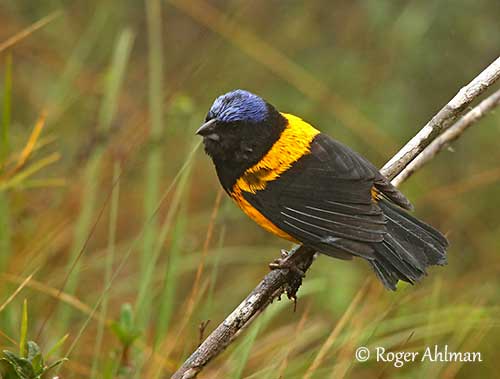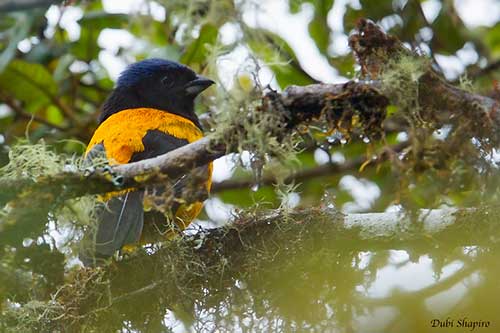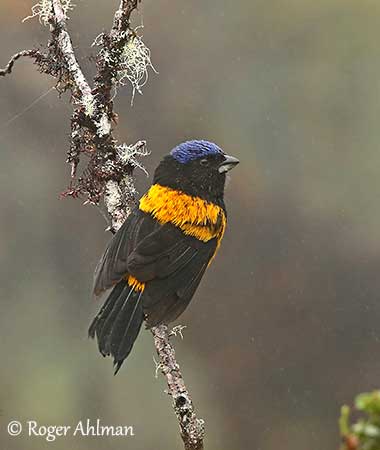
PROTECTION / THREATS / STATUS:
The Golden-backed Mountain Tanager has very restricted range in which it is uncommon to locally fairly common.
This species is threatened by fragmentation and loss of the habitat. The elfin forests are vulnerable to grazing and fires, involving the reduction of suitable habitats and leading to the lowering of the treeline.
The small population is estimated at 250/2,500 mature individuals, roughly equivalent to 370/3,800 individuals in total. This small population is declining slowly.
The Golden-backed Mountain Tanager is currently listed as Endangered.
Fr: Tangara à dos d’or
Ang: Golden-backed Mountain Tanager
All: Goldrücken-Bergtangare
Esp: Tangara Dorsidorada
Ita: Tanagra montana dorsodorato
Nd: Goudrugbergtangare
Sd: gulryggig bergtangara
Photographers:
Roger Ahlman
Pbase Galleries Peru and Ecuador
Dubi Shapiro
Dubi Shapiro Photo Galleries
Text by Nicole Bouglouan
Sources:
HANDBOOK OF THE BIRDS OF THE WORLD Vol 16 by Josep del Hoyo- Andrew Elliot-David Christie – Lynx Edicions – ISBN: 9788496553781
TANAGERS: Natural History, Distribution and Identification (Helm Identification Guides) - By Morton L. Isler and Phyllis R. Isler - Christopher Helm Publishers Ltd; New edition (30 April 1999) - ISBN-10: 0713651164
BIRDS OF PERU by Thomas S. Schulenberg, Douglas F. Stotz, Daniel F. Lane, John P. O’Neill, Theodore A. Parker III – Princeton University Press 2007– ISBN: 978-0-691-13023-1
BIRDS OF SOUTH AMERICA – Passerines - by Robert S. Ridgely and Guy Tudor – HELM Field Guides – ISBN: 9781408113424
Neotropical Birds – Cornell Lab of Ornithology
Conociendo Nuestras Aves - Perú
Thraupidae – Tanagers & Allies
Golden-backed Mountain Tanager
Buthraupis aureodorsalis
Passeriformes Order – Thraupidae Family
INTRODUCTION:
The Golden-backed Mountain Tanager is endemic to Peru where it lives in a very restricted range in NC Peru. It is found in upper montane forest and shrubbery near the treeline, on the E slope of the Andes. This is a fairly rare species.
It feeds on fruit, seeds and insects, from the ground to the treetops, but mainly in midstory in small trees. It can be seen in pairs or in small groups. The breeding behaviour is poorly known.
The Golden-backed Mountain Tanager is usually uncommon or locally fairly common. It is threatened by habitat loss and fragmentation, involving the decline of the small population.
The species is currently listed as Endangered.
DESCRIPTION OF THE BIRD:
Biometrics:
Length: 23 cm
Weight: 75-94 g
The Golden-backed Mountain Tanager is a large tanager with beautiful appearance.
Crown and nape are deep blue. Face, chin and throat, down to upper mantle above and to mid-breast below, are black.
On the upperparts, lower mantle, scapulars, rump and uppertail-coverts are bright orange-yellow with some sparse dusky and brownish markings. On the upperwing, the lesser wing-coverts are deep blue but rarely visible. Rest of upperwing including median and greater coverts, flight-feathers and tertials, is black. The tail is black too.
On the underparts, lower breast, belly and flanks are bright orange-yellow. There are several arrow-like chestnut spots and streaks on belly and body sides. Lower belly and undertail-coverts are chestnut. The thighs are yellow at front and chestnut behind. On the black underwing, the axillaries are bright yellow, and there is a small, yellow patch on the outer edge of the bend of the wing.
The stout, conical, two-tone bill has blackish upper mandible and paler lower mandible. The eyes are dark brown. Legs and feet are dark grey to blackish.
Male and female are similar.

The immature resembles adult but its plumage is duller. The lesser wing-coverts are less blue than in adults.
RANGE:
The Golden-backed Mountain Tanager is found on the eastern slope of the Andes in NC Peru, from La Libertad to Huánuco.
HABITAT:
The Golden-backed Mountain Tanager frequents the elfin forest with Clusia and Escallonia plant species. It favours large forest patches with adjacent grassland.
It is usually uncommon to very local in upper montane forest and shrubbery near the treeline. The species occurs up to 3,000/3,500 metres of elevation.
CALLS AND SONGS: SOUNDS BY XENO-CANTO
The Golden-backed Mountain Tanager gives various sharp or thin notes such as metallic, squeaky “chit”, “wheet” and “heet” sometimes mixed together.
Within the foraging flocks, the birds produce thin “swee” notes. They also may engage in a bout of calling after several silent minutes. In flight, they give a high-pitched “steet-steet”.
The song is usually given around dawn and in the early morning. It is a fast rhythmic series of loud squeaky or churring notes, each repeated 4-6 times before going on to the next phrase.
BEHAVIOUR IN THE WILD :
The Golden-backed Mountain Tanager feeds mainly on berries and insects found from the ground to the treetops. Seeds are also part of its diet.
It forages most frequently in the midstory, feeding mainly in trees covered with moss, less than three metres above the ground. It remains in a tree during some time, before reaching another tree. It picks food items from mosses and lichens on the branches, often hanging or leaning down to reach the food. It usually moves quietly and slowly.

The Golden-backed Mountain Tanager is usually observed in pairs or in small groups. It may sometimes join mixed-species flocks.
The breeding behaviour is very poorly known. The tanagers are usually monogamous and defend a territory. The nest is usually a simple open cup.
The Golden-backed Mountain Tanager is resident.
It often flies off short distances with undulating flight between the foraging areas. It usually calls while taking flight and flies low over the forest, before to disappear into the dense foliage.
REPRODUCTION OF THIS SPECIES:
The breeding behaviour of the Golden-backed Mountain Tanager is unknown.
The tanagers usually build a cup-shaped nest with dry leaves, plant fibres, ferns, dry grass and moss. The cup is lined with softer materials. Both adults often share the nest building.
Numerous tanager species are monogamous. One or two young are raised, but the clutches are often larger at higher elevations.
Some observations indicate brooding females in September, and juveniles and immatures are found in July, October and November.
More information is needed.
